By far the largest single donation ever made to the Sedgwick Museum consisted of 37,659 fossils collected by a London solicitor - Reginald Marr Brydone FGS (1873-1943), writes Douglas Palmer*
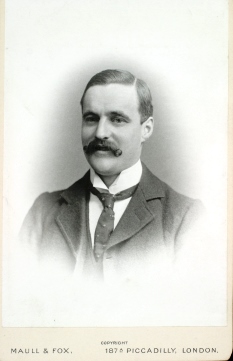 What is surprising is that few people have ever heard of Brydone, even amongst professional palaeontologists. The reason may be that Brydone’s remarkable donation consists largely (over 60%) of Cretaceous age fossil bryozoans. Whilst bryozoans, also known as ‘moss animals’, are a very interesting group of fossils, they are under-appreciated by the general public. So who was Brydone, why did he collect so many bryozoan fossils and how come they ended up in the Sedgwick Museum?
What is surprising is that few people have ever heard of Brydone, even amongst professional palaeontologists. The reason may be that Brydone’s remarkable donation consists largely (over 60%) of Cretaceous age fossil bryozoans. Whilst bryozoans, also known as ‘moss animals’, are a very interesting group of fossils, they are under-appreciated by the general public. So who was Brydone, why did he collect so many bryozoan fossils and how come they ended up in the Sedgwick Museum?
Picture: Thomas Brydone. From the Society's photo portrait collection.
The Brydone collection
Brydone’s fossil collection is enormous by any standards and represents a unique effort by someone who was clearly a very keen palaeontologist and stratigrapher but also an amateur in the best sense of the word. To amass a collection of this size Brydone must have devoted a huge amount of time and energy to this particular group of fossils.
Brydone’s achievements are even more impressive when it is realized that he also collected a further 18,358 fossil specimens from the Chalk Group of Hampshire. Most of these are held by the British Geological Survey (BGS) at Keyworth but some are in the Natural History Museum in London (Walker et al. 2017). Further Brydone collections are held by the Ipswich and Norwich museums. Taking this into account, Brydone’s total collection amounted to well over 50,000 specimens.
Not only did Brydone collect Chalk bryozoans but he also made a special study of them, describing 472 new species and varieties in a series of 56 academic papers. In the process he became a recognized expert in the field who was not afraid of criticizing professionals and in particular Dr W.D. Lang FRS of the British Museum (Natural History).
Very little was known about Reginald Marr Brydone until recently when Paul Taylor and colleagues from London’s Natural History Museum published a biographical memoir and account (Taylor et al. 2018) of the notoriously acrimonious dispute Brydone had with fellow bryozoologist W.D. Lang (1878-1966).
Family background
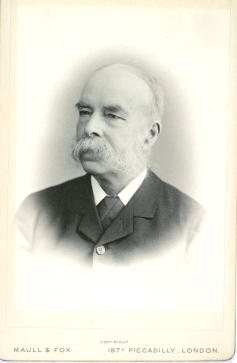
Brydone’s was a privileged upbringing typical of a well established middle-class Edwardian family. Of Scottish origin, his father became a successful solicitor and steward of Petworth House in Sussex. And when he died in 1901, Reginald, his only offspring, inherited £12,000, which would be worth over a million pounds today. At the age of eight, Reginald was sent as a boarder to the old-established public school Winchester College. Evidently a bright student, he was awarded a scholarship in 1887. And, the College archives show that Reginald was a keen sportsman playing cricket, football, gymnastics and rowing. He also took up an early interest in geology, encouraged by Charles Griffith (1833-1925, FGS 1905 - picture, right), an Oxford Classics graduate who taught science including geology at the school. As with so many palaeontologists, it would seem that this teenage enthusiasm was the source of the fossil collecting ‘bug’ which ‘infected’ the rest of his life. It must have further gained hold when in 1891 Reginald was awarded a prize for the best collection of fossils by the college’s Natural History Society.
Admitted to New College, Oxford in 1892, Reginald Brydone matriculated in 1894 with a First in the notoriously difficult Classics Moderations exams. However he must have kept up his interest in geology as he was elected to a Burdett-Coutts Scholarship to continue his degree studies in geology. At the time, the scholarship was awarded as a result of an examination and Brydone went on to graduate with a First in Natural Sciences (Geology) in 1896 when he was also elected as a Fellow of the Geological Society of London.
Earning a living
With such high quali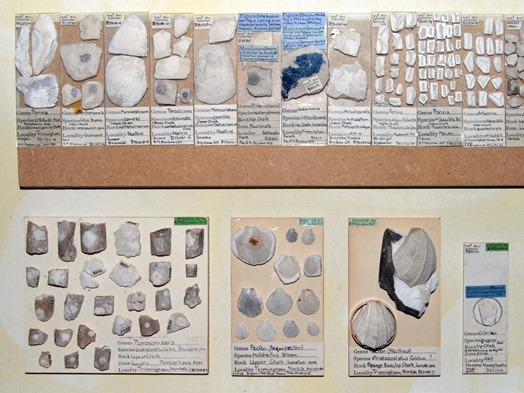 fications, Reginald Brydone could have become one of the rapidly growing class of professional geologists employed by the expanding civic universities and museums and the geological surveys across the Empire. However, he chose not to and instead followed in his father’s footsteps and became a solicitor. Again he showed his considerable intellectual ability with a First Class Honours in his solicitor’s exams along with a prize from New Inn, one of the Inns of Court and the Law Society’s Mellersh Prize in 1900. By this time he was practising law in London’s exclusive Mayfair district.
fications, Reginald Brydone could have become one of the rapidly growing class of professional geologists employed by the expanding civic universities and museums and the geological surveys across the Empire. However, he chose not to and instead followed in his father’s footsteps and became a solicitor. Again he showed his considerable intellectual ability with a First Class Honours in his solicitor’s exams along with a prize from New Inn, one of the Inns of Court and the Law Society’s Mellersh Prize in 1900. By this time he was practising law in London’s exclusive Mayfair district.
Picture left, and below - photographs of Brydone's collection at the Sedgwick Museum.
Virtually nothing is known about Brydone’s professional and private life at this stage except that he rented rooms in a succession of London localities. The fact that he also served as Secretary to the Trustees of the London Stock Exchange gives some indication of the general regard in which he must have been held by the members of the Stock Exchange.
At some point in the early 1900s Brydone bought a house at Mundesley in Norfolk. With money from his father’s estate and his earnings as a solicitor, he was well enough off to retire there in 1918 aged 45. However, his retirement may well also have been forced upon him by the onset of periostitis of the femur. He had to endure this debilitating condition for the rest of his life. But it did not stop him from being ‘able to ride a bicycle after a fashion’ as he wrote to the Sedgwick Museum’s curator A.G. Brighton in 1939.
The amateur palaeontologist
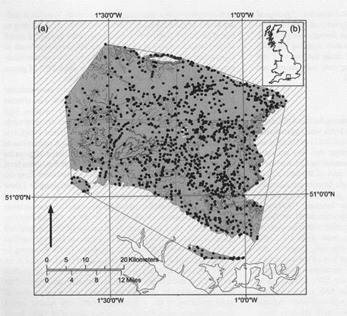
Brydone’s career as a serious collector may have continued fairly seamlessly from his school days with Griffith’s encouragement and perhaps collaboration. Indeed Griffith was collecting from localities around Winchester and publishing fossil lists from them (1886, 1891 and in 1911 in collaboration with Brydone). Curation of Brydone’s 18,358 Hampshire Chalk fossils by the BGS shows that they were collected from some 1198 localities across the outcrop (image, right). Walker et al.’s 2017 map (Fig. 1, p. 512) of Brydone’s sample localities, shows that he (and Griffith?) must have covered more than 2000 sq km in the process. As Lang remarked in his obituary of Brydone (Lang, 1944, p. lxvi) ‘the mere distance walked must have been quite an achievement’.
Brydone’s collecting had a specific purpose and method – the mapping of Chalk biozones (Walker et al. 2017 p. 512) and ‘this led him to employ a thorough and consistent collecting method, with a requirement to achieve a spatially uniform coverage..’. Moreover, all these specimens were collected for a single publication in 1912 with its remarkable biozonal map. This privately published paper on ‘The stratigraphy of the Chalk of Hants’ shows that Brydone must have collected all this material over the first decade of the 20th Century, when he was still working as a solicitor in London.
But Brydone’s interest in bryozoans started before 1909 as that is the date of his first academic paper ‘Notes on New or Imperfectly Known Chalk Bryozoa (Polyzoa)’ (Geological Magazine, 1909. Dec.5, 6, 337-339).
Bryozoans
Bryozoans are an interesting and surprisingly complex group of small aquatic invertebrates. Mostly marine filter feeders with over 6,000 living species, they are still a very successful group and have an evolutionary history that stretches back to Early Ordovician times.
Bryozoans generally form clonal colonies a few centimetres in size, made of numerous interconnected millimetre-sized zooids that produce tube- or box-shaped skeletons. The tubes are made of either organic chitin or calcium carbonate and colonies grow into a variety of forms from bush, stick and fan shapes to sheets that encrust firm surfaces such as rocks or seaweed.
Brydone was particularly interested in a particular group of marine bryozoans called the cheilostomes with calcium carbonate skeletons. Cheilostomes diversified rapidly into hundreds of genera during late Cretaceous times, survived the end Cretaceous extinction and expanded into the most successful and varied group of bryozoans with some 50 families alive today.
Brydone became a serious student of the Chalk bryozoans, especially those he was finding locally in Norfolk. Although their small size required detailed and careful preparation and observation, Brydone soon realized that he had found species either not previously described or which were but poorly known.
Evidently confident of his own abilities and knowledge Brydone determined to correct the matter. The first of his 56 academic papers, written in 1900 when he was 27 years old, was a 16 page account of ‘The Stratigraphy and Fauna of the Trimmingham [sic] Chalk’. As Walker et al. (2017) have suggested, Brydone’s initial concern was the general biostratigraphy of the Chalk and to this end he was sampling the entire fauna. Privately published, the paper showed that right from the start of his ‘academic’ activities Brydone had the means and determination to try and disseminate his views. However, it is very difficult for such privately published papers to get much of a distribution and consequently they do not carry much scientific weight. Whether Brydone realized this himself or was advised by a correspondent, his next contribution was published in the Geological Magazine. This contribution and the next five, all short and published in 1906, were further notes about the Trimingham Chalk, its stratigraphy and fauna.
By 1909, Brydone was increasingly focussing his palaeontological activities on the description of ‘New or Imperfectly Known Chalk Bryozoa’. A further 17 or so short papers continued the same theme up to 1913, followed by another 20 papers up to 1918 on similar Chalk themes, all published in the Geological Magazine.
Conflict with W.D. Lang
It was Brydone’s detailed work on Chalk cheilostome bryozoans that brought him into sharp conflict with the leading British palaeobryozoologist of the day – William Dickson Lang (1878-1966 - picture). Lang had read Natural Sciences with Zoology at Pembroke College in the University of Cambridge from 1898. Graduating in 1902, he immediately joined the British Museum (Natural History) where he was to spend the rest of his working life, eventually becoming Keeper of Geology in 1927. Upon joining the museum, Lang had been delegated to deal with ‘lower invertebrate’ fossil groups - protozoans, sponges, corals, bryozoans and a miscellany of others.
Lang was in the habit of publishing very brief preliminary descriptions of new bryozoan species without supporting illustrations. These were followed up by extensive monographic works published in the 1920s by the British Museum (Natural History) where the species were illustrated. But in the meantime, it was virtually impossible for anyone to recognize or identify Lang’s new species.
In 1929 Brydone put his detailed and lengthy criticisms of the ‘salaried public servant’ Lang in print, reverting to his earlier vehicle of private publication. By doing so, he avoided any peer or editorial review for such criticisms would not have gone unchallenged if the work had been submitted to the Geological Magazine or any other academic journal. Produced in three parts between 1929 and 1936, Brydone’s monograph was illustrated with 42 photographic plates, which included new species and revisions of his previously published species.
Brydone wrote that if Lang’s ‘”diagnoses” are to be accepted as valid descriptions of species, we must regard precision and thoroughness as unscientific and foolish’. Another contentious issue was Lang’s advocacy of the theory of orthogenesis whereby evolution was thought to follow predetermined pathways, which became non-adaptive and finally led to the extinction of the lineage (see Taylor 2002 for a detailed discussion of Lang’s use of orthogenesis). In particular, Lang employed orthogenesis as an explanation for the extinction of many of the evolutionary lineages he recognized in the cribrimorph cheilostome bryozoans. Brydone was uninhibited in his ridicule of this aspect of Lang’s work - ‘A theory of this kind is almost as elusive as a Christian Science argument.’ (Brydone, 1929, p.6).
Donation
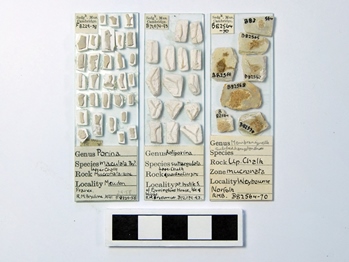 A significant result of Brydone’s antipathy to Lang was his donation in the late 1930s of the bulk of his extensive collections to the Sedgwick Museum rather than the British Museum (N.H.) which already held extensive collections of British and foreign bryozoans, especially those from the Chalk.
A significant result of Brydone’s antipathy to Lang was his donation in the late 1930s of the bulk of his extensive collections to the Sedgwick Museum rather than the British Museum (N.H.) which already held extensive collections of British and foreign bryozoans, especially those from the Chalk.
Following such published ‘broadsides’, Lang was in little doubt that he had in some way offended Brydone. In a letter written in 1944 to Wilford Norman Edwards, Lang’s successor as Keeper of Geology in the British Museum (N.H.), Lang admitted that ‘It has long been on my conscience that, probably by lack of perception and tact, I alienated Brydone’s material from the museum.’
For a modern opinion of Brydone’s work on Chalk stratigraphy, Professor Rory Mortimore, an expert on Upper Cretaceous stratigraphy, makes the following statement:
‘His original work on the Chalk of Hampshire, partly with his teacher at Winchester School (Griffith and Brydone, 1911), and wonderful hand painted map of the zones of the Chalk of Hampshire (Brydone, 1912) has been essential to determining geological structure (I used his map to draw structure contours and then see whether lateral variations in the Chalk were related to folds and faults).
He was one of the first to provide good measurements of exposures such as those in the Chalk cliffs of Brighton (previous workers such as Rowe did not do this). He also had a long-term spat with C.T.A. Gaster who produced zonal maps of the Chalk in the South Downs of Sussex. The zonal maps did not match-up at the Sussex Hampshire boundary and Brydone was not happy with Gaster’s redefinition of his (Brydone’s) Offaster pilula Zone.
As well his zonal mapping and section logs Brydone made a very large contribution to Chalk palaeontology..’ and ‘… made an immense contribution to the Chalk of Norfolk and elsewhere.’
Conclusion
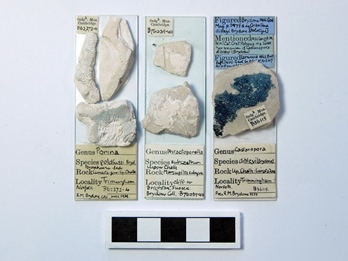 In retrospect Brydone was correct in his criticism of the theory of orthogenesis, which was already pretty well outmoded when Lang was using it so enthusiastically as a foundation of his ideas about cribimorph cheilostome bryozoan evolution. And Brydone was also right to be critical of Lang’s practice of introducing new taxa without enough supporting data to make them identifiable, even if he did later produce that information. However, Brydone does seem to have escalated his criticism of Lang beyond an academic dispute into a more personal one. And, Brydone did have ‘form’ when it comes to strong criticism of the work of other professional geologists. In his earliest papers he took the eminent Geological Survey officer Clement Reid to task over aspects of Chalk stratigraphy. And, as Professor Mortimore notes above, he also had a dispute with C.T.A. Gaster, who from the 1920s until the 1950s published numerous papers on the stratigraphy of the Chalk, especially in the Proceedings of the Geologists’ Association.
In retrospect Brydone was correct in his criticism of the theory of orthogenesis, which was already pretty well outmoded when Lang was using it so enthusiastically as a foundation of his ideas about cribimorph cheilostome bryozoan evolution. And Brydone was also right to be critical of Lang’s practice of introducing new taxa without enough supporting data to make them identifiable, even if he did later produce that information. However, Brydone does seem to have escalated his criticism of Lang beyond an academic dispute into a more personal one. And, Brydone did have ‘form’ when it comes to strong criticism of the work of other professional geologists. In his earliest papers he took the eminent Geological Survey officer Clement Reid to task over aspects of Chalk stratigraphy. And, as Professor Mortimore notes above, he also had a dispute with C.T.A. Gaster, who from the 1920s until the 1950s published numerous papers on the stratigraphy of the Chalk, especially in the Proceedings of the Geologists’ Association.
The Brydone story does perhaps carry a salutary lesson for professional geologists in their dealings with the amateurs whose work has and will continue to support palaeontological research.
Acknowledgment and references: with kind permission of the authors much of this account is derived from ‘Reginal Marr Brydone (1873-1943) and his scientific animosity with William Dickson Lang (1878-1966)’ by Paul D. Taylor, Holly Mackinlay and Hellen Pethers in Annals of Bryozoology 6: aspects of the history of research on bryozoans. Edited by Patrick N. Wyse Jackson and Mary E. Spencer Jones, 2017. Thanks also to Paul Taylor for SEM images of bryozoans; Fiona Walker for permission to reproduce the map of Brydone’s localities in Hants and Professor Rory Mortimore for comments upon Brydone’s Chalk stratigraphy and a copy of his 1912 map.
Further reading
- Griffith, C and Brydone, R.M. 1911. The Zones of the Chalk in Hants, Dulau and Co. Ltd., London.
- Brydone, R.M. 1912. The Stratigraphy of the Chalk of Hants
- Taylor, P.D. 2002. W.D. Lang, orthogenesis and the evolution of cribrimorph Bryozoa. 275-298. In: Wyse-Jackson, P.N. and Spencer Jones, M.E. (eds). Annals of Bryozoology. International Bryozoology Association, Dublin.
- Walker, F.M., Dunhill, A.M., Woods, M.A., Newell, A.J. and Benton, M.J. 2017, assessing sampling of the fossil record in a geographically and stratigraphically constrained dataset: the Chalk Group of Hampshire, southern UK. Journal of the Geological Society, 174, 509-521.
* Douglas Palmer, Sedgwick Museum
Postscript
Douglas Palmer adds: Lang may have been responsible for the Geological Magazine discontinuing publication of Brydone’s papers between 1920 and 1941. As Lang wrote: ‘I feel more culpable for probably having been the cause of Dr Henry’s [Woodward, then editor of the Geological Magazine] discontinuing B’s articles on new Chalk Polyzoa…After several of these had appeared, Dr H asked me if I thought he had better continue them. Of course I did not advise him one way or the other, but tried to give him as disinterested a view of their value as I could….All I know is that Dr H did discontinue the series as a sequel to his conversation with me…’
However, the discontinued publication in the Geological Magazine may well have been due to a change of editorship. By the 1920s the journal was struggling to attract significant contributions and the appointment of R.H. Rastall (1871-1950), an economic geologist, to assist and then take over from Woodward who was a palaeontologist, may have been the real cause of the change, which Brydone took such exception to. If so, it is somewhat ironic that Lang should be blamed for the action of a member of the Department of Geology in Cambridge.